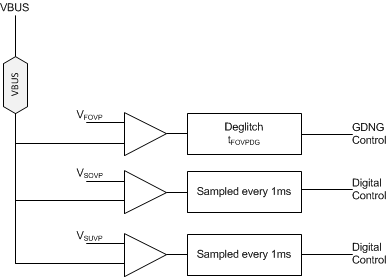ZHCSFH8D August 2016 – January 2018 TPS25741 , TPS25741A
UNLESS OTHERWISE NOTED, this document contains PRODUCTION DATA.
- 1 特性
- 2 应用
- 3 说明
- 4 修订历史记录
- 5 Device Comparison Table
- 6 Pin Configuration and Functions
- 7 Specifications
-
8 Detailed Description
- 8.1 Overview
- 8.2 Functional Block Diagram
- 8.3
Feature Description
- 8.3.1 USB Type-C CC Logic (CC1, CC2)
- 8.3.2 9.3.2 VCONN Supply (VCONN, CC1, CC2)
- 8.3.3 USB Power Delivery BMC Transmission (CC1, CC2, VTX)
- 8.3.4 USB Power Delivery BMC Reception (CC1, CC2)
- 8.3.5 Discharging (DSCG, VPWR)
- 8.3.6 Configuring Voltage Capabilities (HIPWR, EN9V, EN12V)
- 8.3.7 Configuring Power Capabilities (PSEL, PCTRL, HIPWR)
- 8.3.8 Gate Drivers
- 8.3.9 Fault Monitoring and Protection
- 8.3.10 Voltage Control (CTL1, CTL2)
- 8.3.11 Sink Attachment Indicator (UFP, DVDD)
- 8.3.12 Accessory Attachment Indicator (AUDIO, DEBUG)
- 8.3.13 Plug Polarity Indication (POL)
- 8.3.14 Power Supplies (VAUX, VDD, VPWR, DVDD)
- 8.3.15 Grounds (AGND, GND)
- 8.3.16 Output Power Supply (DVDD)
- 8.4 Device Functional Modes
- 9 Application and Implementation
- 10Power Supply Recommendations
- 11Layout
- 12器件和文档支持
- 13机械、封装和可订购信息
8.3.9.1 Over/Under Voltage (VBUS)
The TPS25741 or TPS25741A uses the VBUS pin to monitor for overvoltage or undervoltage conditions and implement the fast-OVP, slow-OVP, and slow-UVP features.
 Figure 37. Voltage Monitoring Circuits
Figure 37. Voltage Monitoring Circuits
If an over-voltage condition is sensed by the Fast OVP mechanism, GDNG is disabled within tFOVP + tFOVPDG, then a Hard Reset is transmitted and the VBUS discharge sequence is started. At power up the voltage trip point is set to VVFOVP (5 V contract). When a contract is negotiated the trip point is set to the corresponding VFOVP value.
The devices employ another slow over-voltage protection mechanism as well that sends the Hard Reset before disabling the external NFET. It catches many OV events before the Fast OVP mechanism. During intentional positive voltage transitions, this mechanism is disabled (see Figure 1). However, tVP after the external NFET has been enabled if the voltage on the VBUS pin exceeds VSOVP, a Hard Reset is transmitted to the Sink then the VBUS discharge sequence is started. Once a Power Delivery contract has been negotiated, if the voltage on the VBUS pin exceeds the selected voltage threshold (VSOVP) a Hard Reset is transmitted to the Sink then the VBUS discharge sequence is started.
The devices employ a slow under-voltage protection mechanism as well that sends the Hard Reset before disabling GDNG. During intentional negative voltage transitions, this mechanism is disabled (see Figure 1). However, tVP after the external NFET has been enabled if the voltage on the VBUS pin falls below VSUVP, a Hard Reset is transmitted to the Sink then the VBUS discharge sequence is started..